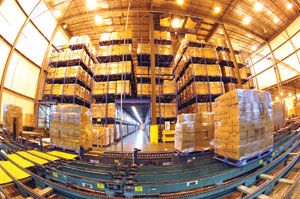HP Hood’s Winchester, Va., plant is a beacon of efficiency. Its nine packaging lines, which operate 24/7, don’t seem to know the meaning of the word “quit.”
The plant, which was originally built in 2000 and expanded over the next four years, rests in the historic Shenandoah Valley and serves markets east of the Rocky Mountains, as well as Walmart stores across the U.S., by way of key transportation arteries by which the plant is strategically located.
HP Hood packs several different product lines here, including Lactaid and other Hood brands such as Calorie Countdown, as well as some dairy and non-dairy beverages for others. And while product demand has increased, Hood has continually updated its technology to meet those needs. In 2008, the plant processed some 100 million gallons.
Fill 'er up!
No plant can be without its workhorse, and Winchester boasts several for filling and packaging.On the aseptic side, a Shibuya aseptic filler was installed in 2005, which can fill up to 600 bottles per minute, according to Jim Sylvester, senior director of operations at the Winchester facility. Every 30 minutes, a computer prints out data that shows whether or not the filler is meeting operation parameters. If the data isn’t printed in green, which signifies that the equipment is performing as it should, then adjustments are made as needed.
As for extended shelf life (ESL), a separate room houses two active Serac fillers, which assures a sterile environment. It is made up of three sections: one for sterilization with a hydrogen peroxide solution, one for rinsing bottles with sterile water and one where bottles are filled and capped with a foil seal.
And just like how Mom made everything from scratch, Hood’s Winchester facility performs on-site blow molding. The site features a Sidel blow-molding machine, which can make up to 34,000 bottles per hour. It was installed in 2004 and became a vital addition to the filler, which previously gave blowmolders a run for their money, simply because they could not keep up. Since then, it has worked to keep up with increasing demand.
“It’s really helped our efficiency,” says Marc Humphreys, operations manager at the Winchester facility. “[The blow molder] runs faster than the filling machines, so when they fill the line, it shuts off.”
Bountiful bottles
Hood is also taking a forward stride in innovation with its bottles. It uses polyethylene terephthalate (PET) and high-density polyethylene (HDPE) bottles with materials supplied by Graham Packaging.Although ESL plastic packaging has been around for several years, further developments of the aseptic single-serve plastic container continue.
“In 2008, our customers, as well as consumers, were adapting more to this product than they were before,” says Scott Blake, senior vice president of operations for HP Hood. “It allows our customers to use different channels to get their product to market in the aseptic area.”
The advantage that Hood’s customers can reap is in being able to use distributors that don’t have cold chain refrigeration capabilities. This also opens up new markets for those customers.
Moo-ving into multipacks
Currently, the biggest project the plant is working on is putting together four- and six-pack multipack options for its customers in the aseptic field. This is an ambitious product, and they’re working closely with Douglas Machine to make sure the project is a success.“Obviously, you see a lot of multipacks out there, like the Tetra Brik type. But there aren’t a lot of multipacks out there when you get into the plastic arena,” says Blake. “It’s coming, particularly in the aseptic side of the business. It will be more and more prevalent in 2009.”
For Hood, multipacks open a new channel of business, allowing products to be sold at club stores. While it may be too early to tell, Blake says he expects the multipacks will be even more popular than the single-serve products.

HP
Hood’s Winchester
facility’s warehouse, which has more than 19,000 pallet spaces, has an
efficient computer-controlled storage and retrieval system for plastic packaged
products that pulls pallets based on load-out priority.
The warehouse side
After bottle preforms are blow molded, filled, capped and sleeved, they are palletized and wrapped. Each pallet is labeled with a code that determines whether it goes to the “paper” or “plastic” side of the warehouse.The warehouse has more than 19,000 pallet spaces, and while pallets holding paper-packaged products are manually forklifted, plastic-packaged products have a computer-controlled storage and retrieval system that pulls pallets based on priority for load-out.
“This plant produces so much so fast, if a line goes down, it’s like dominoes-everything’s got to fall into place,” says Humphreys.
And while having innovative equipment is important for a plant to operate, it’s only useful if the staff knows how to use it. The plant is constantly training its employees, including regular refresher classes held between scheduled sessions, as well as yearly computer training and tests that must be done by everyone.
An in-house quality team also keeps food safety a priority. Peggy Poole, Hood’s vice president of quality systems and regulatory affairs, points out that the company’s quality management system includes food safety initiatives such as ingredient testing, lot trace and recall, in-process quality control, supplier testing and requirements, Hazard Analysis Critical Control Points, allergen controls, transportation guidelines, split sample programs and bio-security guidelines.
“When it was started up with all new people, the challenge was training everybody to get it running efficiently,” says Blake. “Today, it’s one of the most efficient facilities in the industry.”
EDITOR’S NOTE: Background for this article was provided by James Dudlicek, chief editor ofDairy Foods, a sister publication ofFood & Beverage Packaging.
Douglas Machine Inc.
320-763-6587;www.douglas-machine.com
Graham Packaging
717-849-8500;www.grahampackaging.com
Serac
630-510-9343;www.serac-group.com
Shibuya-Hoppman Corp.
800-368-3582;www.shibuya-int.com
Sidel
678-221-3000;www.sidel.com
AT-A-GLANCE
Company: HP Hood LLCPlant location: Winchester, Va.
Size: 441,500 square feet
Employees: 400
Operating hours: 24 hours per day, seven days per week
Products: Milks, creams, non-dairy, specialty beverages (protein/sports drinks)
Packaging: PET, HDPE, paper gable top
No. of packaging lines: 9 (8 ESL and 1 aseptic)
